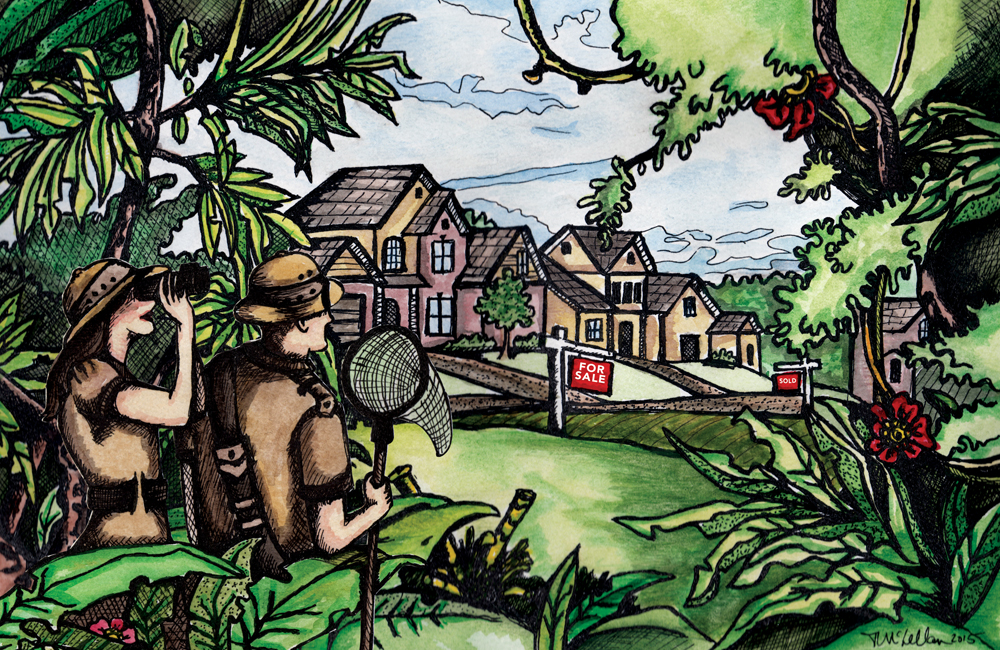That’s how local realtors describe the resale home market in Southern Georgian Bay as it continues to slowly edge towards a balanced market, fuelled by demand for our four-season recreational lifestyle and the number of empty nesters, retirees and even young families wanting to buy a little piece of Paradise
by Janet Lees
 While the Toronto real estate market continues its breakneck pace, our local market is seeing more slow and steady growth. The reason? For most, purchasing a home here is discretionary – those looking for a second home, and even those looking to retire to Southern Georgian Bay, don’t have to buy and can afford to take a wait-and-see approach, or hold out for just the right home at just the right price.
While the Toronto real estate market continues its breakneck pace, our local market is seeing more slow and steady growth. The reason? For most, purchasing a home here is discretionary – those looking for a second home, and even those looking to retire to Southern Georgian Bay, don’t have to buy and can afford to take a wait-and-see approach, or hold out for just the right home at just the right price.
However, local realtors are seeing an increasing trend towards young families moving to the area, thanks to a new take on the age-old ‘three Ls’ of real estate – lifestyle, lifestyle, lifestyle.
“Since a large part of our market is fueled by discretionary purchasing, I would say that the better economic outlook in general is having a positive impact on the local real estate market,” said Desmond von Teichman, broker of record for Royal LePage Locations North. “Many people don’t HAVE to buy up here, they WANT to buy up here. Before they make a big decision like that, they look at external factors such as their stock holdings and RRSPs.”
Andres Paara, also of Royal LePage Locations North, agreed that the slow but continued improvement in both the Canadian and U.S. economies is gradually giving potential buyers a greater level of comfort to act on their plan to buy a recreational, semi-retirement or retirement property, or make their next move to their next home.
“With the market slowly headed to a balanced market and with fewer properties available than in previous years, the discretionary and slow-to-take-action buyers may be more motivated to pull the trigger on a purchase,” explained Paara.
“We are seeing more young families buying recreational properties again, as well as the about-to-be retired and retired moving from the GTA to our region to enjoy the active four-season lifestyle our region provides. Our region continues to be a steady slow, but continued, growth region. Slow and steady is, in my opinion, better that sharp spikes and dips.”
The Numbers
Home sales in Southern Georgian Bay hit a new record in 2013.
“Resale housing demand was strong overall in 2013, with all sales recorded via the association’s MLS system reaching their highest annual level in six years,” said Wayne Cornfield, president of the Southern Georgian Bay Association of Realtors. “Residential sales recorded through the MLS system came in at above average levels in 2013.”
Overall, 2,683 homes were sold in 2013, up 2.8 per cent from 2012 and above both the five- and 10-year averages. Monthly sales outperformed those of 2012 for nine out of the 12 months of 2013 and came in close behind 2012 number in the other three months.
As this issue of On The Bay went to press, the first quarter report for 2014 was not yet available, but the year was off to a disappointing start due mainly to extreme weather that kept both visitors and potential buyers away in January and February.
“Travel conditions were often hazardous and many properties remained snowbound, affecting access and the ability of potential buyers to fully appreciate the outdoor components of the landscape of properties, to say nothing of the willingness of property hunters to venture out into the winter storms to view listings and keep their scheduled appointments,” noted Barb Thompson of Chestnut Park Realty.
“It is difficult to pinpoint and quantify the impact of any one factor on market trends, but property sales did continue to lag behind last year’s pace, which was compounded in part by a lower inventory of available properties. February sales were 3 per cent behind last year, and year-to-date figures remain 14 per cent behind last year’s pace. Despite the ‘polar vortex’, sellers were able to bring out 428 new properties on the market, which was 6 per cent more than last year. That was not enough to make up for January’s shortfall in new supply.”
East vs. West
While our area lags behind the still-booming Toronto market, the good news is that we are significantly outperforming neighbouring towns to the east of the Georgian Triangle.
In 2013, two real estate boards merged to form the Southern Georgian Bay Association of Realtors (SGBAR), which now serves a huge region from Meaford to Midland. The new association represents two very distinct markets – the Western District and the Eastern District. The Western District includes Wasaga Beach, Collingwood, Clearview Township, The Blue Mountains, Municipality of Meaford and Grey Highlands, while the Eastern District encompasses Midland, Penetanguishene, Elmvale, Port McNicoll, Victoria Harbour, Coldwater, Port Severn, Honey Harbour and Tiny, Tay, Springwater, Oro-Medonte, Severn and Georgian Bay Townships.
“The big story in 2013 was the strength of demand in the Western District along the south shore of Georgian Bay, where sales topped the 1,800 mark for the first time ever,” said the SGBAR’S Cornfield. “The Western District saw 1,845 homes sold in 2013 – a new annual record, at eight per cent above 2012 levels.”
In contrast, annual home sales in the Eastern District totaled only 838 units, down six per cent from 2012. “That is a little below average from the standpoint of recent history, which has seen activity bounce around roughly in the 800 to 900 range since 2008.”
Pulling out the six key areas of the Georgian Triangle (Collingwood, Clearview, Blue Mountains, Wasaga Beach, Meaford and Grey Highlands), residential sales were up 3.87 per cent in 2013 over 2012, suggesting some stability in the marketplace, noted Marg Scheben-Edey, broker with Remax Four Seasons Realty in Collingwood.
“Within those areas, almost 59 per cent of all the residential sales took place in Collingwood and Meaford, which suggests demand is still strongest in the full-time, local resident market.”
But while the Western District is generally a stronger market, it also has the capacity to be more affected by weather conditions, and that is exactly what happened in January and February this year.
“Significantly reduced sales activity during the first two months of 2014 in the Western District clearly illustrates the difference in market dynamics between east and west due to the impacts the winter recreational market has on real estate in this area,” said Cornfield. “While we have experienced one of the snowiest and longest ski and snowboard seasons in recent years, adverse weather conditions, an abundance of snow, and frequent road closures, especially on weekends, have adversely impacted property showing activity and subsequent sales.”
On the positive side, if weather was the culprit for slow winter sales, the arrival of spring could start to see a turnaround. “As spring approaches, we anticipate robust market conditions to prevail, thus helping to make up some of the shortfall in sales activity felt through January and February,” said Cornfield.
Balancing the Market
The terms ‘buyer’s market’ and ‘seller’s market’ are often bandied about, but the true definition of those terms relates to supply and demand, reflected in the sales-to-listing ratio (the ratio between the number of homes sold and the number of new listings entering the market).
“Our sales-to-listing ratio is on the climb,” noted Andres Paara. “We started 2013 at below 20 per cent and ended the year at almost 33 percent. The lower the number, the more of a buyer’s market we are in. As the number climbs closer to the 45 to 55 per cent range, we approach a balanced market (equally favouring the buyer and the seller). This also is reflected in that we are enjoying a greater number of sales of properties and fewer number of listings year-over-year.”
While overall, our region may be inching toward a more balanced market scenario, Marg Scheben-Edey cautioned that the sales-to-listing ratio can vary greatly in individual communities.
“We have micro markets in the Georgian Triangle and it is very important to consider your own market individually,” said Scheben-Edey. “For example, the year-end residential sales-to-listing ratios in Collingwood and Clearview are over 40 per cent and in stable market territory – neither a buyer’s nor seller’s market – whereas the Town of Blue Mountains at a 30 per cent ratio is still solidly in buyer’s market conditions.”
In the Beaver Valley and Grey Highlands, another micro market, a shortage of listings is balancing out the market somewhat, but is offset by choosy buyers, said Helen Lightbody of Clairwood Real Estate in Kimberley. “Usually we have a limited supply of properties, and the buyers are pretty specific about what they are looking for and there is never a rush to find it.”
Another factor keeping our market in check is the discretionary nature of not only home purchases, but sales as well. “While the market still favours the buyer, we are seeing a trend towards balance, and again, the oddities of a discretionary market come in to play here,” said von Teichman. “Just the same way some buyers don’t need to buy, they want to buy, some sellers don’t need to sell, they want to sell.”
With higher sales and fewer active listings on the market in 2013 versus 2012, there was a slight bump in prices overall. However, Anita Lauer of Chestnut Park Realty notes that price increases in 2013 were moderate.
“A tighter market means more buyers competing for fewer properties, which inevitably pushes prices up,” explains Lauer. “That appears to be playing out in the Georgian Triangle, but fortunately the area has for the most part been able to contain price increases to a measured and sustainable rate.”
The bottom line: buyers can’t necessarily expect to buy at a ‘fire sale’ price, and sellers can’t necessarily expect to make a killing on selling their home.
How Prices Stack Up
The average residential sale price for the area in 2013 was $332,953 compared to $320,525 at the end of 2012. “This amounts to only a 3.9 per cent increase, which bodes well for affordability – one of the key underpinnings for the ongoing health and stability of the Georgian Triangle real estate market,” said Lauer.
According to the SGBAR’s Cornfield, the largest percentage of 2013 sales – 44 per cent – was in the $200,000 to $349,999 price range. Homes priced under $199,999 accounted for 30 per cent of sales, and about 24 per cent of homes sold were priced at $350,000 to $499,999 – 16.1 per cent increase in sales over 2012.
“The upper end market is active, with 25 sales in the $800,000 to $999,999 range, and 31 sales over $1 million,” said Cornfield.
However, while the ‘luxury’ end of the market impacts the total dollar volume, it actually represents a very small percentage of sales.
“It is worth noting that almost 90 per cent of all sales in our region on the MLS system are in the under $500k price range,” says Andres Paara. “Only 10 per cent of the sales are greater than $500k.”
The high end of the market – homes priced at over $1 million – is especially challenging, said Paara. “There are quite a lot of properties available for sale in that bracket and a very limited number of buyers compared to the lower price ranges,” he noted, pointing out that less than 1.5 per cent (31) of all MLS-listed properties sold in 2013 sold for over $1 million dollars.
This has a particular impact in the Blue Mountains, which tends to have a higher number of homes priced over $1 million.
“We did notice that when the sales in the high end of the market were lagging through the first two quarters of 2013, the municipality of the Blue Mountains’ average sale price was also lagging,” said Paara. “As the year came to a close and the high end of the market sales caught up and surpassed the sales numbers of 2012, so did the average sale price in the Blue Mountains, ending the year at 6.3 per cent higher than the previous year.”
The low end of the market also has its challenges, noted Claire Weston of Royal LePage Trinity Realty in Stayner. “The most challenging price range is the $150-200,000 category in our area,” said Weston. “Everyone wants ‘move-in ready,’ and usually when homes are priced under $200,000 for a two- to three-bedroom home, there is a lot of work.”
So far in 2014, despite an overall reduction in sales year-to-date, upper end home sales continue to remain bullish, says SGBRA’s Cornfield. “Whiles sales under $200,000 are down 14 per cent with sales in the $200-$350,000 range off by 25 per cent, sales between $400-$500,000 have almost doubled so far this year,” said Cornfield. “Similarly, sales between $500-800,000 are up 80 per cent while sales between $700-800,000 have tripled in the first two months of the year, with six properties sold compared to just two in 2013.”
Regardless of price category, all of the realtors On The Bay interviewed cautioned sellers against over-pricing a home. Today’s buyers are savvy, and do their homework. They are likely to know how one home stacks up against another, and what the price should be based on location, age of the home, and features. While emotions tend to run high, sellers have to be realistic – just because you love your home doesn’t mean someone else will, nor will they be willing to pay a premium for your happy memories.
“As always, the market is VERY price sensitive,” said Scheben-Edey. “Less than 40 per cent of homes listed for sale actually sell, and this is often due to over-pricing.”
The Condo Market
MLS condo sales were 374 in 2013 compared to 1,356 single family home sales – less than 30 per cent of the market. “However, to add context, 374 condo resales is the most condo resales ever recorded in our area,” said von Teichman. “Condominium ownership is on the rise practically everywhere in this country. I don’t imagine this market will be any different.”
However, Paara sees the condo market as more challenging, again in part due to the discretionary nature of many condo purchases. “The condo market represented approximately 21.6 per cent of total sales in 2013 and 21.3 per cent in 2012, between the freehold single family and the condo sales. Very little change year over year, and I expect the same trend to continue.”
While a little over 20 per cent of all residential sales in our area are condos, in Collingwood and the Blue Mountains, condos represent a whopping 40 per cent of all residential sales, “so they are a significant driver in our market,” said Scheben-Edey.
She adds, “Analyzing the condo market is almost impossible as it is made up of several micro markets – investment, recreational, in-town, older, newer; basically sales are up marginally in 2013 versus 2012 in pace with the single family market. Prices have softened and the big challenge in this sector has been rising condo fees, aging units and special assessments, which are increasingly common for the unplanned repair or replacement of major common elements.”
Demographics
Retired and semi-retired boomers continue to be attracted to Southern Georgian Bay for the active four-season lifestyle and services our region offers.
However, other demos are also starting to play a bigger role in our local real estate market.
“We are seeing more families transitioning to have their home/principal residence in our region and buying a pied-à-terre in the city,” said Paara.
“This is often made possible as a result of the ability for the income earner in the family to retain their city career and income by working ‘virtually’ for two to three days a week from their home here, thanks to the internet and other technology, and only going into the city for a couple of days per week.” He added more buyers are trading in their Muskoka, summer-only use properties and opting instead for four seasons, year-round use in our area.
Scheben-Edey added that in her practice, she is seeing an “unprecedented number” of clients wanting to buy investment property in the area.
“Everything from income units to renovate and flips to recreational condos in rental programs. People are trying to leverage their assets.”
Max Hahne, broker with Sotheby’s International Realty, said he is also seeing investors looking to buy in Southern Georgian Bay – particularly foreign investors. “The currency advantage over the Canadian Dollar is placing Canadian real estate at the forefront for international investors,” said Hahne. “We are seeing a definitive increase in inquiries from foreign buyers in the last six months.”
Having a more diverse mix of potential buyers bodes well for the future of real estate in our area, accorting to Scheben-Edey.
“People talk about this area being a retirement community and to some degree, that is a force in our market. We also, however, have investors, second home buyers and, I’m seeing a growth in affluent young families exiting the city to raise their families here. I think we’ll see more of that.”
Looking Ahead
For 2014, the outlook remains positive, if cautiously so.
“There are so many factors to be weighed in a discretionary market that can impact us,” said von Teichman. “Continued low interest rates and positive economic outlooks could be good macro indicators for us. On a local level, the excellent winter and super skiing could be great for the market. More people up north enjoying themselves means more potential buyers. On the negative side, might the declining Canadian dollar erode consumer confidence and make people put off a decision to buy up here? Perhaps.”
But while some people may be holding off on a purchase, our region remains in high demand due to its many amenities, recreational opportunities and relaxed lifestyle.
“We continue to see a premium being placed on proximity to amenities associated with lifestyle,” said von Teichman. “While this is not unique to our area, its importance seems to be amplified.”
He sees some of the trends we saw in 2013 continuing this year. “I expect to see an increase in sales over $1 million, and the firming up of prices in tighter markets such as the Collingwood sub-$250,000 category,” he predicted. “As the year rolls on, I think we will start to hear more about new condo project starts and sales as inventory tightens.
“I expect that prices will change in pace with inflation, and we will see a general strengthening of our real estate market as consumer confidence grows.”
Paara concurred. “I hear often from people visiting and recreating in our area about their dream and desire to move to and enjoy our area. As such, I expect our real estate markets to continue to develop and be strong for many years to come.” ❧













